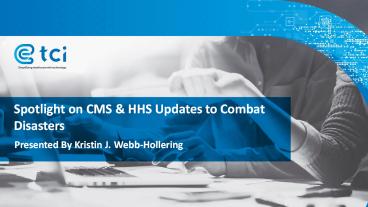Spotlight on CMS & HHS Updates to Combat Disasters - PowerPoint PPT Presentation
Title:
Spotlight on CMS & HHS Updates to Combat Disasters
Description:
The critical importance of steady healthcare is essential to combat disasters like Hurricanes’ Harvey, Irma, and Maria. Federal efforts aim to assist providers and their staffs through crises like these, but in the aftermath as practices try to rebuild, the process of leafing through complicated waivers, claims, and resources can be daunting. – PowerPoint PPT presentation
Number of Views:11
Title: Spotlight on CMS & HHS Updates to Combat Disasters
1
Spotlight on CMS HHS Updates to Combat
Disasters Presented By Kristin J. Webb-Hollering
2
Todays Webinar Agenda
- The who, what, when, where, and why of a Public
Health Emergency - An overview of the Stafford Act and federal
declarations - The reimbursement guidelines of the 1135 Waiver
- CMS restrictions, exceptions, and more during and
after a disaster - The lowdown on timetables, extensions, geography,
and state information - Coding and billing resources for submitting
claims after a catastrophic event - The HIPAA rules under an 1135 Waiver and Public
Health crisis - Health IT basics on securing health records and
systems - How the National Disaster Medical System
Definitive Care Reimbursement Program works - Provider information on compliance and
reimbursement relief efforts in the wake of
Hurricanes Harvey, Irma, and Maria
3
Emergency Declarations
- Before, during, or after a natural disaster like
Hurricane Irma, the governor of a U.S. state or
territory declares a State of Emergency. - Here is the timeline of how an emergency is
declared. - First, a governor issues a State of Emergency due
to a disaster that devastates an area in a state
or territory. During this time, some municipal
and/or state executive, judicial, and legislative
services may be suspended. - The State of Emergency tells the federal
government that the state needs additional
resources to handle the incident. - Next, the President of the United States
acknowledges that an emergency exists under the - Stafford Act or the National Emergencies Act.
4
What is the Stafford Act?
- The Stafford Act, which is short for the Robert
- T. Stafford Disaster Relief
- and Emergency
- Assistance Act, allows federal organizations to
assist state and local governments after the
President of the United States declares a
natural disaster an emergency.
- Definitions of emergency and major disaster fall
under Title I, Section 102 of the Act. It is
interesting to note that - emergency relates to any occasion when state
or local governments need federal help. A
major disaster refers specifically to natural
catastrophes such as hurricanes, floods,
earthquakes, fires, and the like.
Stafford Act
Definitions
5
Public Health Emergency Overview
- WHO
- Usually, after the President establishes an
emergency under the Stafford Act, then the
Secretary of the Department of Health and Human
Services (HHS) declares a Public Health
Emergency (PHE). - WHAT
- The HHS Secretary determines theres a PHE under
Section - 319 of the Public Health Service Act (PHSA).
6
Public Health Emergency Overview
- WHEN
- A Section 319 PHE is good for a duration of 90
days, but it may be shortened by the the HHS
Secretary if its determined an emergency no
longer exists. - WHERE
- The PHE covers the state and/or local areas
referenced in the HHS Secretarys declaration
under Section 319 of the PHS Act only.
7
Public Health Emergency Overview
- Why
- The Secretary determines that theres a high risk
of disease and disorder due to the emergency or
disaster. The hazards are significant enough to
declare the PHE. Under Section 319 of the PHSA,
the Secretary can now offer grants, do
investigations, support state and local
healthcare efforts, and waive certain federal
requirements that may be compromised due to the
disaster.
8
From Emergency to the 1135 Waiver
The President declares an emergency or disaster
A disaster or emergency occurs.
A state of emergency is called by a governor.
under the Stafford Act or the National
Emergencies Act for the impacted areas or state.
Once the PHE is determined, Section 1135 of the
Social Security Act authorizes the HHS
Secretary to waive or modify certain Medicare,
Medicaid, CHIP, and HIPAA requirements.
The HHS Secretary declares a Public Health
Emergency under the Public Health Service Act,
Section 319.
9
Public Health Emergency Fun Fact
The Secretary of the Department of Health and
Human Services can determine a Public Health
Emergency under Section 319 of the Public Health
Service Act without the Presidential declaration
of an emergency under the Stafford or National
Emergencies Acts. However, for certain federal
health programs regulations that fall under the
Social Security Act (i.e. Medicare, Medicaid,
CHIP) to be waived with an 1135 Waiver, the
President must declare an emergency under the
Stafford or National Emergencies Act and the HHS
Secretary must declare a Public Health Emergency
under Section 319 of the Public Health Service
Act.
10
Review the requirements that must be met to make
the 1135 Waiver possible . . .
Requirements can now be waived or modified
under section 1135 of the Social Security Act.
Presidential declaration under Stafford or
National Emergencies Act
HHS Secretary determination of a Public Health
Emergency
11
(No Transcript)































